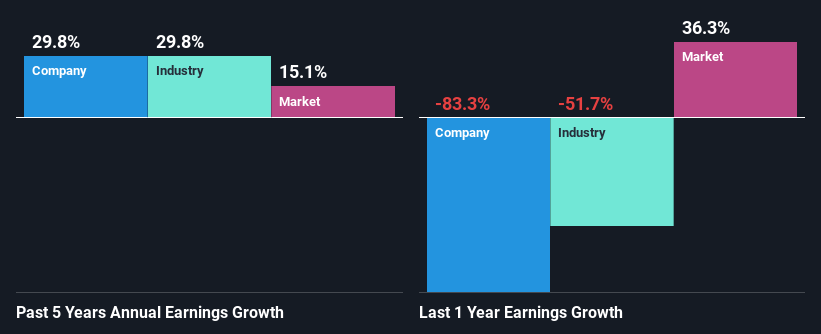Has Polaris Infrastructure Inc.'s (TSE:PIF) Impressive Stock Performance Got Anything to Do With Its Fundamentals?
Most readers would already be aware that Polaris Infrastructure's (TSE:PIF) stock increased significantly by 16% over the past three months. As most would know, fundamentals are what usually guide market price movements over the long-term, so we decided to look at the company's key financial indicators today to determine if they have any role to play in the recent price movement. Particularly, we will be paying attention to Polaris Infrastructure's ROE today.
ROE or return on equity is a useful tool to assess how effectively a company can generate returns on the investment it received from its shareholders. In other words, it is a profitability ratio which measures the rate of return on the capital provided by the company's shareholders.
View our latest analysis for Polaris Infrastructure
How Is ROE Calculated?
The formula for return on equity is:
Return on Equity = Net Profit (from continuing operations) ÷ Shareholders' Equity
So, based on the above formula, the ROE for Polaris Infrastructure is:
1.5% = US$4.0m ÷ US$260m (Based on the trailing twelve months to March 2022).
The 'return' is the amount earned after tax over the last twelve months. One way to conceptualize this is that for each CA$1 of shareholders' capital it has, the company made CA$0.02 in profit.
What Is The Relationship Between ROE And Earnings Growth?
So far, we've learned that ROE is a measure of a company's profitability. Based on how much of its profits the company chooses to reinvest or "retain", we are then able to evaluate a company's future ability to generate profits. Assuming everything else remains unchanged, the higher the ROE and profit retention, the higher the growth rate of a company compared to companies that don't necessarily bear these characteristics.
A Side By Side comparison of Polaris Infrastructure's Earnings Growth And 1.5% ROE
It is hard to argue that Polaris Infrastructure's ROE is much good in and of itself. Even when compared to the industry average of 6.4%, the ROE figure is pretty disappointing. In spite of this, Polaris Infrastructure was able to grow its net income considerably, at a rate of 30% in the last five years. We reckon that there could be other factors at play here. For instance, the company has a low payout ratio or is being managed efficiently.
As a next step, we compared Polaris Infrastructure's net income growth with the industry and found that the company has a similar growth figure when compared with the industry average growth rate of 30% in the same period.
The basis for attaching value to a company is, to a great extent, tied to its earnings growth. It’s important for an investor to know whether the market has priced in the company's expected earnings growth (or decline). Doing so will help them establish if the stock's future looks promising or ominous. One good indicator of expected earnings growth is the P/E ratio which determines the price the market is willing to pay for a stock based on its earnings prospects. So, you may want to check if Polaris Infrastructure is trading on a high P/E or a low P/E, relative to its industry.
Is Polaris Infrastructure Making Efficient Use Of Its Profits?
The three-year median payout ratio for Polaris Infrastructure is 47%, which is moderately low. The company is retaining the remaining 53%. This suggests that its dividend is well covered, and given the high growth we discussed above, it looks like Polaris Infrastructure is reinvesting its earnings efficiently.
Besides, Polaris Infrastructure has been paying dividends over a period of six years. This shows that the company is committed to sharing profits with its shareholders. Our latest analyst data shows that the future payout ratio of the company is expected to rise to 70% over the next three years.
Conclusion
In total, it does look like Polaris Infrastructure has some positive aspects to its business. Despite its low rate of return, the fact that the company reinvests a very high portion of its profits into its business, no doubt contributed to its high earnings growth. Having said that, looking at the current analyst estimates, we found that the company's earnings are expected to gain momentum. Are these analysts expectations based on the broad expectations for the industry, or on the company's fundamentals? Click here to be taken to our analyst's forecasts page for the company.
Have feedback on this article? Concerned about the content? Get in touch with us directly. Alternatively, email editorial-team (at) simplywallst.com.
This article by Simply Wall St is general in nature. We provide commentary based on historical data and analyst forecasts only using an unbiased methodology and our articles are not intended to be financial advice. It does not constitute a recommendation to buy or sell any stock, and does not take account of your objectives, or your financial situation. We aim to bring you long-term focused analysis driven by fundamental data. Note that our analysis may not factor in the latest price-sensitive company announcements or qualitative material. Simply Wall St has no position in any stocks mentioned.

 Yahoo Finance
Yahoo Finance 
